Analyzing Amazon Brand Analytics: A must-have for brand sellers

|
Brand Analytics is one of the features provided by Amazon for sellers who have registered their brands. It provides sellers with extremely valuable analysis reports to help brand sellers make wise decisions about products and marketing. Data Availability: Displays the availability of Brand Analytics data.
Benefits of using Brand Analytics Compiled by ✎ Mary/ Statement: When reprinting this article, the title and original text must not be modified, and the source and original link must be retained. |
<<: How to write an Amazon tracking email?
Recommend
Mexican toy market research: e-commerce platform sales increased 10 times, with Lego and other brands being the most popular
According to VML's latest research, Lego, Nint...
What is StreetPricer? StreetPricer Review
StreetPricer is a dynamic repricing, competitor an...
What is FindMyfbid? FindMyfbid Review
FindMyfbid is a tool to find the ID of a FB accoun...
The US toy market is changing, with Amazon and Walmart gaining market share
It is learned that according to foreign media repo...
Back-to-school shopping season extends, consumer shopping habits change
It is learned that recently, according to foreign ...
What is Standard Certification? Standard Certification Evaluation
Shenzhen CeBiao Certification Technology Service C...
Amazon's rule changes on the first day of Black Friday drove operators crazy
The European site has already started the Black Fr...
What is Big Cartel? Big Cartel Review
Big Cartel has built a network platform where fash...
Back-to-school season is here early! The average American household spending will be as high as $377!
It is learned that according to KPMG's "2...
How to view Amazon's off-site discounts?
There are often sellers who don’t know how to dist...
What is Juxiang Cross-border Fingerprint Browser? Juxiang Cross-border Fingerprint Browser Review
JXExplorer is an improvement based on the Chrome p...
What is Amazon frustration free packing? Amazon frustration free packing review
Amazon frustration free packing (FFP for short) re...
131 million people shop online every month! The US e-commerce market will remain hot in 2022!
<span data-docs-delta="[[20,"获悉,据外媒报道,虽然人们...
Don’t know how to shoot a product video? Learn these tips to increase your conversion rate
In recent years, videos have become the king of c...









